Friday, February 12th, 2021 by Julian Karsunky
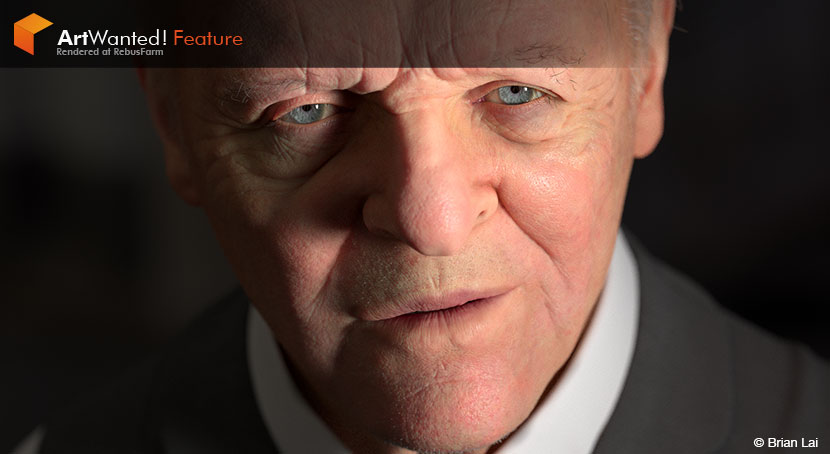
At one point in the critically acclaimed TV series ‘Westworld’, a character refers to humanity as a “thin layer of bacteria”. When taking a closer look at Brian Lai’s lifelike digital portrait of the show’s star, Anthony Hopkins, one might agree to this rather unflattering description: to teach his students the basics of sculpting anatomy, the Malaysian 3D artist and lecturer meticulously handcrafted every single skin pore of his subject. The result, however is much more than the sum of its (microscopic) parts, and stands as an impressive example of Brian’s talent, diligence and keen eye.
In our interview, Brian talks about his background in photography, choosing to remain a hobbyist and the unique joy to be found in human skin.
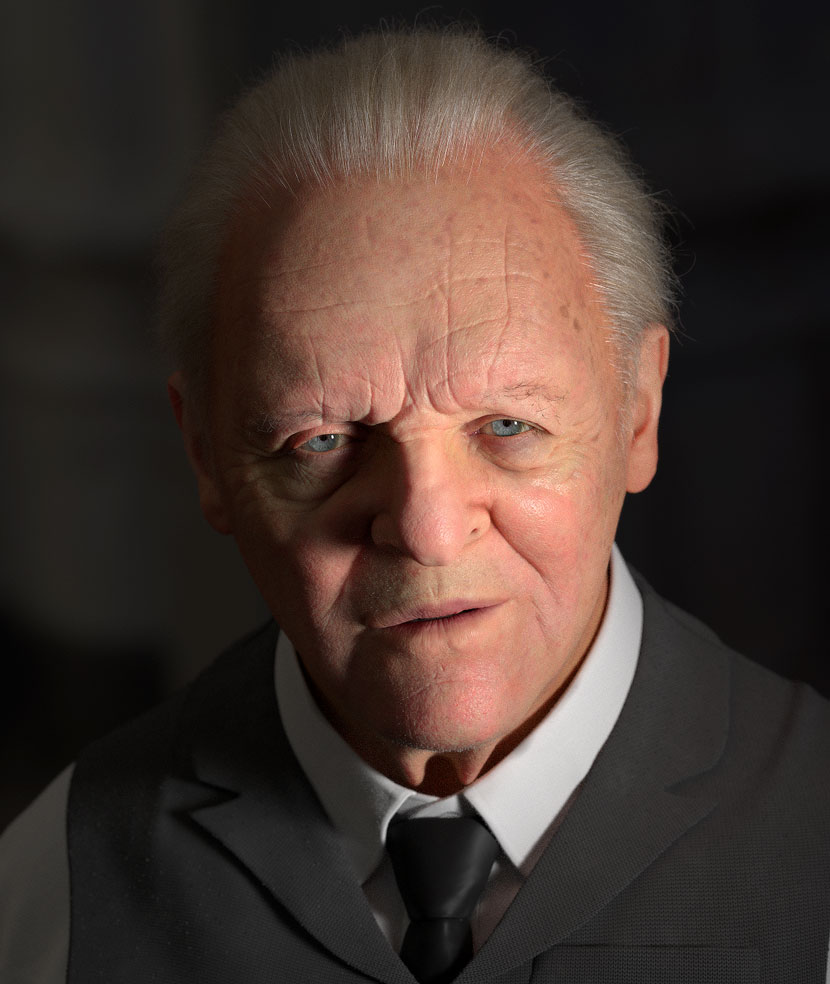 Impressed by the actor’s expressive performance in the HBO-series ‘Westworld’, Brian Lai portrayed Sir Anthony Hopkins in full 3D.
Impressed by the actor’s expressive performance in the HBO-series ‘Westworld’, Brian Lai portrayed Sir Anthony Hopkins in full 3D.
Hi Brian, thanks for joining us! To start things off, please introduce yourself to our readers!
Hi everybody, I’m Brian Lai, I’m a 28-years-old 3D artist based in Penang, Malaysia. I currently work as a lecturer at The One Academy, one of the top CG schools in my country and the place I myself graduated from in 2017.
Do you recall when and how you first consciously encountered CGI?
When first watching ‘Spider-Man 3’ back in 2007, I was amazed by the CG effects when the Sandman made his first appearance. My father bought me a 3ds Max setup disc, that’s where it all began.
When and why did you then decide to pursue a career as a 3D artist?
While Spider-Man 3’s sandman scene was the moment that initially drew me in, it wasn’t what kept me obsessed. I’ve always loved both drawing and physics, but I wasn’t the best student in high school and thought there was no way I could be a scientist and artist at the same time. But then CGI suddenly emerged as the perfect solution, allowing me to delve into physics while also exploring my artistic side.
Although you teach CGI and VFX, you humbly refer to yourself as a hobbyist on your ArtStation page. Why do you not consider yourself a professional?
Oh, you’d be surprised how often I get asked about that! I think the term “professional” is reserved for those who make a living out of their profession, which was never my goal. I initially described myself as a “hobbyist” because I never thought that one day, I too would have a career in this field. I always considered CG purely as a hobby, a passion, maybe even an obsession and I would like to keep that outlook, which is why I still use that descriptor – to always remember why I started this journey in the first place!
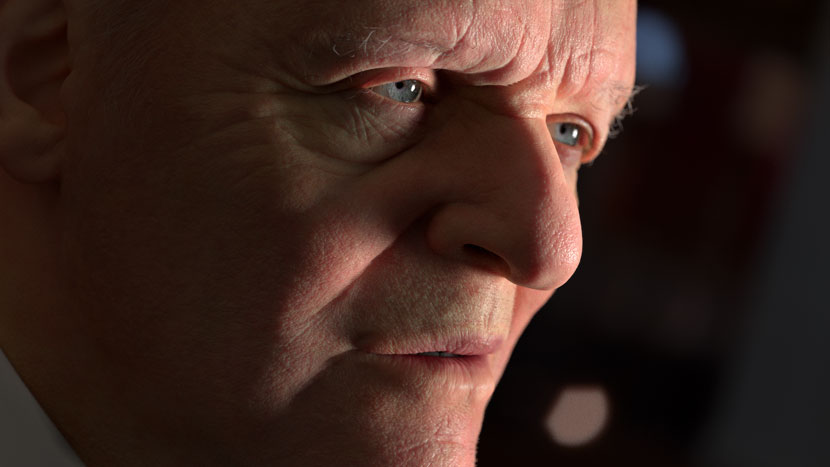 Inspired by the work of digital portraitist Anthony Costa, Brian took a similar approach and painstakingly handcrafted every single skin pore.
Inspired by the work of digital portraitist Anthony Costa, Brian took a similar approach and painstakingly handcrafted every single skin pore.
Please tell us more about your job as a lecturer at The One Academy Penang.
The One Academy is one of the best CG colleges in the world, regularly earning top spots in The Rookies School and College Rankings; I myself have learnt so many things here, both as a student and now as a lecturer! Our mission is to empower and inspire high school graduates, most of whom have no previous experience, to create a better CG environment in Malaysia. The reason I decided to become a lecturer is mainly because I love to share and discuss what I have learnt with others. Another benefit of this job is, it provides me daily opportunities to connect with seasoned industry vets as well as fresh high school graduates, which helps me keep young in a way.
How are you holding up in these trying times? Has the current crisis impeded your work?
Like so many others, the pandemic has forced me to work from home and teaching online is a completely new experience for me. But, as the saying goes, when God closes a door, he opens a window for you at the same time. So, we’re trying to see the positive, such as having more time for learning and discovering. We also record all of our online classes, which allows for easier repetition, if needed. Still, we do hope we can overcome this pandemic and return to normal as soon as possible.
You also have a background in photography and cinematography. How does this artistic inclination influence or translate into your 3D work?
My father was a photographer all his life. I was raised in my father’s printing shop, surrounded by hundreds of cameras all day and night. Developing negatives, printing, photography, and videography were part of my daily routine since I was six years old all the way up to my early twenties. I never knew how proficient I had become in Photoshop over the years until I took a course at The One Academy, then I was like “Oh? So, I’m pretty solid compared to a lot of my peers, huh?” Initially, I was quite proud of myself, but eventually I realized Photoshop was just one of many different CG tools and there was so much more software to learn.
So yeah, my dad influenced me a lot. Working in photography and videography for so long, paying close attention to details has become second nature to me. The precision work required to fix pimples and similar details in our customer’s portraits back then, which shaped me as a 3D artist!
In your experience, what is the current state of the CG industry and community in Malaysia and Southeast Asia?
It is steadily on the rise! Over the last decade, our industries have been involved in many high-profile projects from all over the world. From God of War, Spiderman, Assassin Creed to the Last of Us: Malaysian studios and artists have contributed to all of these titles, and there are countless more examples from blockbuster movies and AAA games. I definitely consider Malaysia to be one of the strongest CG talent pools in all of Southeast Asia right now, and we will only continue to get better in the future.
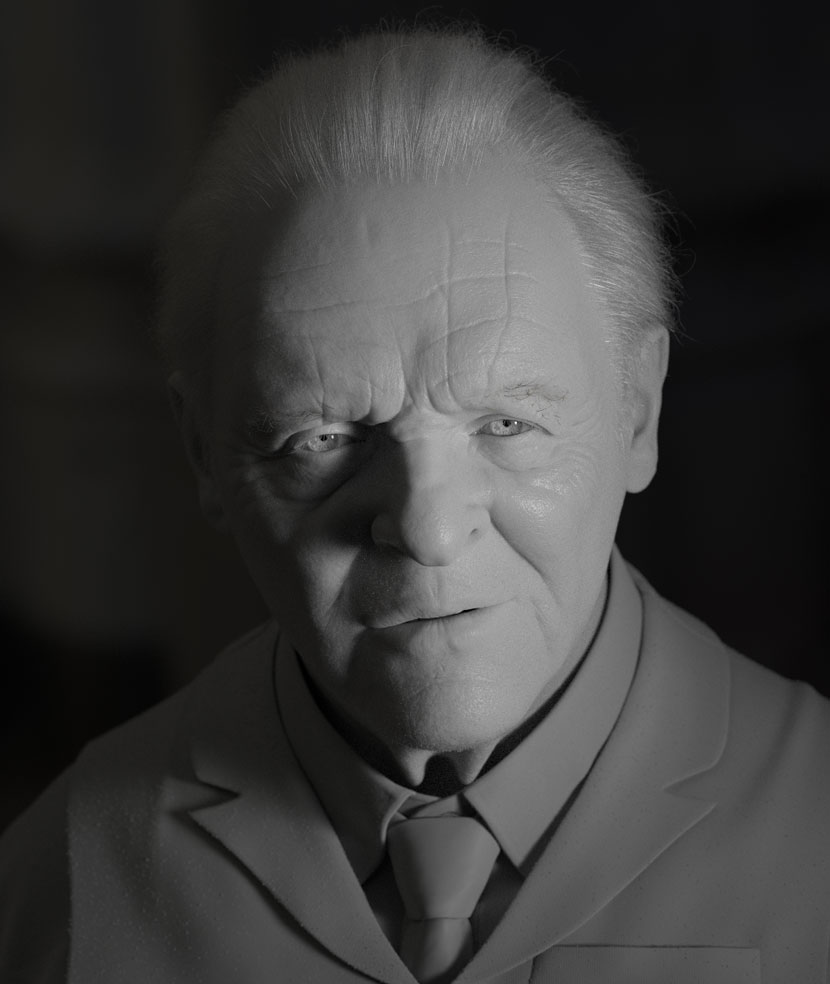 Started as an illustrative model for one of his classes, Brian eventually was engulfed in his digital portrait.
Started as an illustrative model for one of his classes, Brian eventually was engulfed in his digital portrait.
Let’s talk about your work in more detail, namely your photorealistic 3D portrait sculpture of actor Anthony Hopkins.
This project was part of one of my classes, which marks the first foray into ZBrush for most of our students. The course is designed to teach them sculpting from the ground up, the goal is to create a realistic portrait. I’m a big fan of the TV show ‘Westworld’, and Anthony Hopkins, cast as Dr. Ford, gives such a splendid and expressive performance in it. That is why I chose him as a subject.
Getting the skin to look right was one of the most challenging parts. Human skin is one of the most special textures to me, I love the optics reaction, especially when rays hit those layers of skin and refracted color changes is something generally exciting to me. Although the course was finished after 12 weeks, I decided to spend a few additional weeks to touch up the portrait before eventually publishing it.
Seeing how this project was specifically part of a designated learning process, can you walk us through the development process step by step from your perspective as a teacher?
Let me just break it down quickly: the course was held biweekly over the course of 12 weeks, with every session lasting three hours. For the first four weeks, we mainly focus on proportions, anatomy, topology and such. From the fifth to the eighth week, we tackle painting maps, texturing, shaders and lighting and the final four weeks are all about XGen, cameras, rendering, and final composite.
In broader terms, the course covers sculpting anatomy, including materials, optics, and ray tracing, and discussion of various approaches and techniques. If you are interested, feel free to follow me on Instagram, where I post updates regularly!
You prominently cite the work of digital portraitist Kris ‘Antropus’ Costa as an influence and inspiration. What do you admire about his craft and why should aspiring artists learn from him?
Exactly! Kris Costa is a living legend to me; I’m so inspired by his determination to do everything by hand instead of using shortcuts. In this industry, delivering quality work within tight deadlines is the standard, which necessitates cutting corners here and there. In my occasion, however, there are no clients in the conventional sense: since we only aim to and hone our artistic abilities, we can approach a portrait just like a “traditional” artist would.
Back to Costa, I enrolled in one of his courses, which I found to be very helpful and incredibly helpful overall. I very much recommend his course to everybody, although you definitely need to have a certain understanding of Maya to make the most of it.
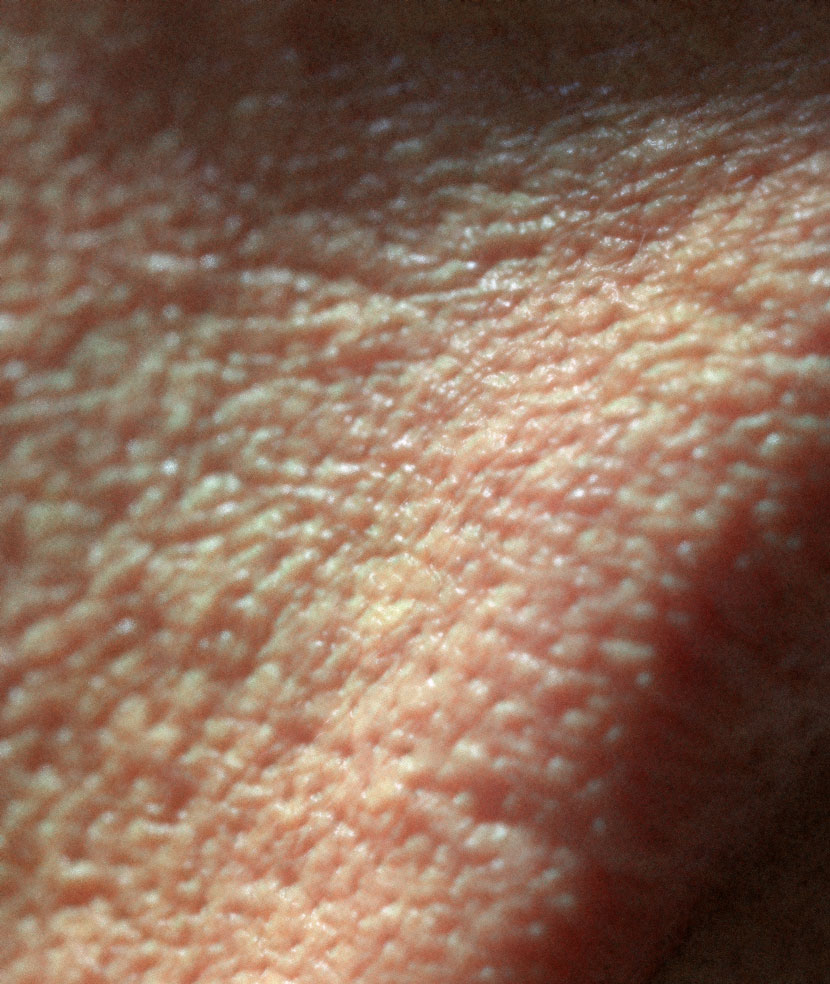 Brian considers human skin to be a very special, albeit challenging texture.
Brian considers human skin to be a very special, albeit challenging texture.
What software did you use to create this piece? Any plug-ins you found particularly helpful?
Mainly Autodesk Maya, ZBrush and V-Ray. I also used MD9 and Substance Painter for some of the accessories, such as the clothing.
Are you satisfied with the results? What has the feedback been like so far?
To be honest, I wish I could have done better! So, I’m not all that satisfied, but at the same time, after looking at the same project every day for 18 weeks straight, you eventually grow a little tired. At some point, you just have to wrap it up and move on. The feedback has been okay, some outlets featured my work, which gave me a little comfort.
What is one thing you yourself have learned from this project that you can share with us?
Practice makes perfect! My previous attempt at a realistic CG portrait failed spectacularly, but I put in the work and while I’m still not completely satisfied, I’m getting the hang of it now.
Considering the path you have already traveled up to this point, what is some advice you would give to aspiring artists?
I’d like to share a quote by Will Smith, which I find not only very inspirational but relevant to our line of work as well:
You don't set out to build a wall. You don't say 'I'm going to build the biggest, baddest, greatest wall that's ever been built. ' You don't start there. You say 'I'm gonna lay this brick as perfectly as a brick can be laid,' and you do that every single day, and soon you have a wall.
This is such a powerful quote to me. Following this approach, instead of trying to do everything at once, I prefer to slow down and make sure every step I take is in the right direction. You can start with a simple object, a 3D model of a phone, a mug or anything small. Give it your all and try to achieve the best results possible, before taking the next step. Then take it from there!
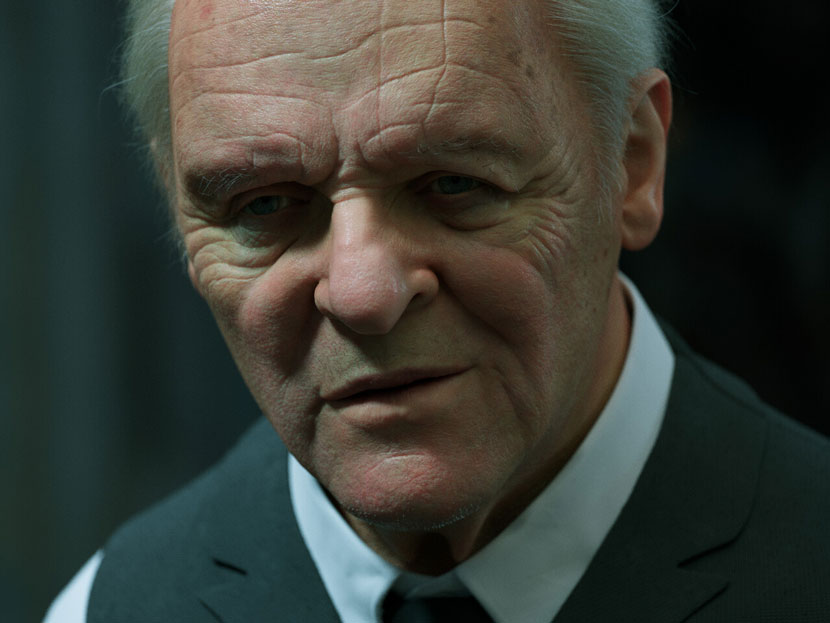 Every wrinkle tells a story: this depiction of Hopkins evokes a desire for “fava beans and a nice chianti”.
Every wrinkle tells a story: this depiction of Hopkins evokes a desire for “fava beans and a nice chianti”.
Please tell us about your previous experience with RebusFarm. Is there anything you especially like about our service?
I think what sets RebusFarm apart from its competitors is that they care about their customers and support the CG community by curating artwork. It’s not just about selling a service. And the prices are definitely fair and affordable for anyone.
In closing, is there anything else you want to say? Any plugs, shoutouts or present or upcoming projects you’d like to mention?
Well, as I mentioned before, I always post my work on Instagram, so please check it out if you’re interested! Just last month, I began working on a 3D portrait of Thanos. Unfortunately, these last few weeks have been so busy, I wasn’t able to dedicate any significant time to it, but I will definitely pick it back up as soon as possible. Last but not least, thank you so much to RebusFarm for featuring my work, it has been an honor!
The pleasure is all ours! Brian, thank you so much for taking the time and all the best in the future!
Keep up with Brian Lai and his work here:
How to join ArtWanted!
You want to get featured in our ArtWanted! campaign and win 250 RenderPoints on top? Submit your work, rendered at RebusFarm, to This email address is being protected from spambots. You need JavaScript enabled to view it.! Visit our Art Wanted! page for more information.
>> Read more articles on our blog
